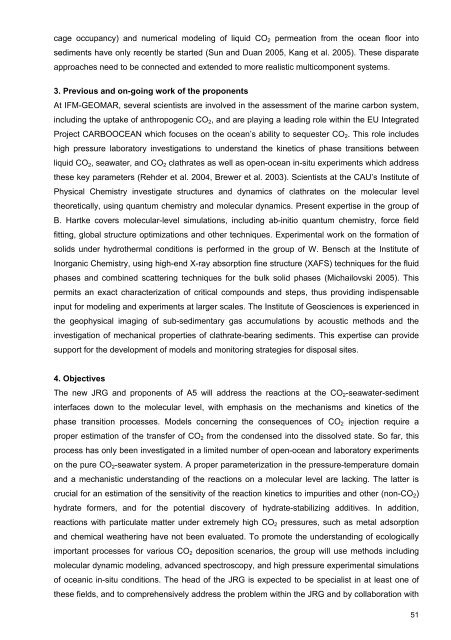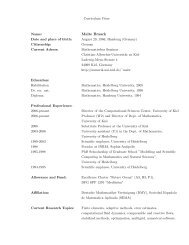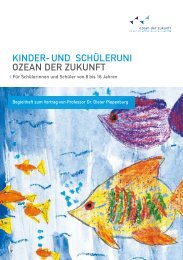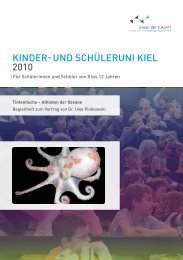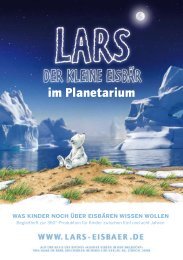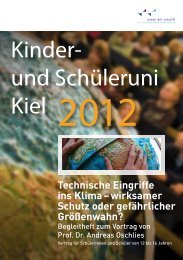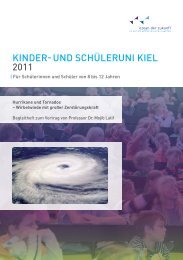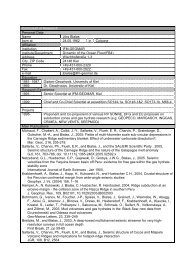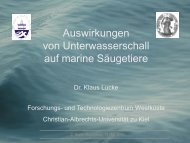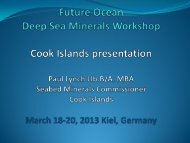cage occupancy) and numerical modeling of liquid CO 2 permeation from the ocean floor intosediments have only recently be started (Sun and Duan 2005, Kang et al. 2005). <strong>The</strong>se disparateapproaches need to be connected and extended to more realistic multicomponent systems.3. Previous and on-going work of the proponentsAt IFM-GEOMAR, several scientists are involved in the assessment of the marine carbon system,including the uptake of anthropogenic CO 2 , and are playing a leading role within the EU IntegratedProject CARBOOCEAN which focuses on the ocean’s ability to sequester CO 2 . This role includeshigh pressure laboratory investigations to understand the kinetics of phase transitions betweenliquid CO 2 , seawater, and CO 2 clathrates as well as open-ocean in-situ experiments which addressthese key parameters (Rehder et al. 2004, Brewer et al. 2003). Scientists at the CAU’s Institute ofPhysical Chemistry investigate structures and dynamics of clathrates on the molecular leveltheoretically, using quantum chemistry and molecular dynamics. Present expertise in the group ofB. Hartke covers molecular-level simulations, including ab-initio quantum chemistry, force fieldfitting, global structure optimizations and other techniques. Experimental work on the formation ofsolids under hydrothermal conditions is performed in the group of W. Bensch at the Institute ofInorganic Chemistry, using high-end X-ray absorption fine structure (XAFS) techniques for the fluidphases and combined scattering techniques for the bulk solid phases (Michailovski 2005). Thispermits an exact characterization of critical compounds and steps, thus providing indispensableinput for modeling and experiments at larger scales. <strong>The</strong> Institute of Geosciences is experienced inthe geophysical imaging of sub-sedimentary gas accumulations by acoustic methods and theinvestigation of mechanical properties of clathrate-bearing sediments. This expertise can providesupport for the development of models and monitoring strategies for disposal sites.4. Objectives<strong>The</strong> new JRG and proponents of A5 will address the reactions at the CO 2 -seawater-sedimentinterfaces down to the molecular level, with emphasis on the mechanisms and kinetics of thephase transition processes. Models concerning the consequences of CO 2 injection require aproper estimation of the transfer of CO 2 from the condensed into the dissolved state. So far, thisprocess has only been investigated in a limited number of open-ocean and laboratory experimentson the pure CO 2 -seawater system. A proper parameterization in the pressure-temperature domainand a mechanistic understanding of the reactions on a molecular level are lacking. <strong>The</strong> latter iscrucial for an estimation of the sensitivity of the reaction kinetics to impurities and other (non-CO 2 )hydrate formers, and for the potential discovery of hydrate-stabilizing additives. In addition,reactions with particulate matter under extremely high CO 2 pressures, such as metal adsorptionand chemical weathering have not been evaluated. To promote the understanding of ecologicallyimportant processes for various CO 2 deposition scenarios, the group will use methods includingmolecular dynamic modeling, advanced spectroscopy, and high pressure experimental simulationsof oceanic in-situ conditions. <strong>The</strong> head of the JRG is expected to be specialist in at least one ofthese fields, and to comprehensively address the problem within the JRG and by collaboration with51
the expertise which already exists in Kiel. This will extend and interconnect the resources of thevarious institutions which are contributing to A5. Use of the gathered process understanding andparameterizations for km-scale models near the release site as well as for ocean-wide models isassured within the framework of established international cooperations as well as by modelingexpertise available in Kiel. <strong>The</strong> evaluation of the biological consequences will be addressed incollaboration with A1, the efficiency of CO 2 removal via deliberate disposal will be compared to thenatural uptake of CO 2 studied in A3, experimental and theoretical methods used are similar toapproaches applied in A6, and the biogeochemical investigation of deliberate CO 2 sequestrationwill support the economical assessments included in A7.5. ReferencesBrewer PG, Peltzer ET, Friederich G, Rehder G (2002) Experimental determination of the fate of aCO 2 plume in seawater. Environm. Science and Technology 36(24), 5441-5446.Chen B, Song Y, Nishio M, Akai M (2005) Modelling of CO 2 dispersion from direct injection of CO 2in the water column. J. Geophys. Res. - <strong>Ocean</strong>s 110, doi:10.1029/2004JC002567.Haugan PM, Alendal G (2005) Turbulent diffusion and transport from a CO 2 lake in the deepocean. Journal of Geophysical Research-<strong>Ocean</strong>s, 110, doi:10.1029/2004JC002583.IPCC, Special report on carbon dioxide capture and storage. (2006)Kang Q, Tsimpanogiannis IN, Zhang D, Lichtner PC (2005) Numerical modelling of pore-scalephenomena during CO 2 sequestration in oceanic sediments. Fuel Processing Technology,86(14-15), 1647-1665.Kheshgi HS, Smith SJ, Edmonds JA (2005) Emissions and Atmospheric CO 2 Stabilization: LongtermLimits and Paths, Mitigation and Adaptation. Strateg. for Global Change 10, 213-220.Michailovski A, Grunwaldt J-D, Baiker A, Kiebach R, Bensch W, Patzke GR (2005) Solvothermalformation of MoO 3 fibers studied by complementary in-situ-EXAFS/EDXRD techniques,Angew. Chemie 117, 5787-5792.Orr JC (2004) Modelling of ocean storage of CO 2 - <strong>The</strong> GOSAC study, Report PH4/37, InternationalEnergy Agency, Greenhouse Gas R&D Programme, Cheltenham, UK, 96 pp.Rehder G, Kirby SH, Durham WB, Stern LA, Peltzer ET, Pinkston J, Brewer PG (2004) Dissolutionrates of pure methane hydrate and carbon dioxide hydrate in under-saturated sea water at1000 m depth. Geochim. Cosmochim. Acta 68, 285-292.Sato T, Sato K (2002) Numerical Prediction of the Dilution Process and its Biological Impacts inCO 2 <strong>Ocean</strong> Sequestration. Journal of Marine Science and Technology, 6(4), 169-180.Sun R, Duan Z (2005) Prediction of CH 4 and CO 2 hydrate phase equilibrium and cage occupancyfrom ab initio intermolecular potentials. Geochim. Cosmochim. Acta 69, 4411-4424.52
- Page 7 and 8: Contents1 General Information about
- Page 9 and 10: 1 General Information about the Clu
- Page 11 and 12: 1.2 Research Program1.2.1 Summary/Z
- Page 13 and 14: 1.2.2.2 ObjectivesThe Future Ocean
- Page 15 and 16: will address the emerging new resea
- Page 17 and 18: Topics Objectives DisciplinesA1 Exa
- Page 19 and 20: development of these new initiative
- Page 21 and 22: Project Objective IndustryPartnersO
- Page 23 and 24: Continued excellence in the field o
- Page 25 and 26: The establishment of several new po
- Page 27 and 28: 1.4.1 Integrated School of Ocean Sc
- Page 29 and 30: ensure that emerging innovations wi
- Page 31 and 32: Institute / DisciplineAcademic Leve
- Page 33 and 34: their orientation according to the
- Page 35 and 36: 1.7.2 Structural Evolution and Qual
- Page 37 and 38: 30- Notes -
- Page 39 and 40: organisms to elevated CO 2 and decr
- Page 41 and 42: ist wahrscheinlich stärker als wä
- Page 43 and 44: out by the proponents and will esta
- Page 45 and 46: Rückkopplungsschleife weitere Erw
- Page 47 and 48: enthic biota of gas release or the
- Page 49 and 50: Synthese, aufbauend auf einer Kombi
- Page 51 and 52: (4) a determination of the impact o
- Page 53 and 54: Einflüsse. Um deren Auswirkungen b
- Page 55 and 56: on longer time scales. The latter t
- Page 57: werden kann. Allerdings sind die ch
- Page 61 and 62: 2. State-of-the-artThe changing com
- Page 63 and 64: • Field and laboratory investigat
- Page 65 and 66: Erwärmung der Ozeane kann zur Frei
- Page 67 and 68: Valuing the Ocean: Research focus a
- Page 69 and 70: submarine earthquakes, slumps and s
- Page 71 and 72: Fischerei ist eine der wichtigsten
- Page 73 and 74: ecosystems. In particular, the foll
- Page 75 and 76: Hochdurchsatztechnologien die Evolu
- Page 77 and 78: microbial diversity on their barrie
- Page 79 and 80: transient three-dimensional fluid f
- Page 81 and 82: modeling, which describe chemical a
- Page 83 and 84: Erdbeben, submarine Hangrutschungen
- Page 85 and 86: Simons 2003) to investigate shallow
- Page 87 and 88: damit zusammenhängender Meeresspie
- Page 89 and 90: B5(1) Sea-Level Rise and Physical-M
- Page 91 and 92: Pickrill RA, Todd BJ (2003) The mul
- Page 93 and 94: Onate E, Piazzese J (2005) Decision
- Page 95 and 96: echtlichen und ökonomischen Rahmen
- Page 97 and 98: marine resources, such as energy ex
- Page 99 and 100: 92- Notes -
- Page 101 and 102: 2. State-of-the-artThe variety of n
- Page 103 and 104: and will benefit from expertise in
- Page 105 and 106: Die Plattform 2 stellt die analytis
- Page 107 and 108: 4. New Cluster TechnologiesIn order
- Page 109 and 110:
(iv) Proteomanalysetechniken und (v
- Page 111 and 112:
4. New Cluster TechnologiesA specia
- Page 113 and 114:
Illustration of existing/emerging a
- Page 115 and 116:
physical parameters (e.g. lowered a
- Page 117 and 118:
etabliert, das insbesondere auf wis
- Page 119 and 120:
2.4.3.2 Central Funds for Transfer
- Page 121 and 122:
International School of Ocean Scien
- Page 123 and 124:
Description Year of purchase Amount
- Page 125 and 126:
3.2 Auxiliary Support3.2.1 Total Fu
- Page 127 and 128:
120- Notes -
- Page 129 and 130:
Suess E, Torres ME, Bohrmann G, Col
- Page 131 and 132:
Schreiber, StefanVisbeck, MartinSri
- Page 133 and 134:
4.3 Third-Party FundingNo. FundingB
- Page 135 and 136:
Leibniz Institute of Marine Science
- Page 137 and 138:
These JRG’s will augment the expe
- Page 139 and 140:
The Cluster is embedded in the “K
- Page 141 and 142:
A14- Notes -
- Page 143 and 144:
4.6 Curricula Vitae and Lists of Pu
- Page 145 and 146:
Curriculum of ResearchPersonal Data
- Page 147 and 148:
Curriculum of ResearchPersonal Data
- Page 149 and 150:
Curriculum of ResearchPersonal Data
- Page 151 and 152:
Curriculum of ResearchPersonal Data
- Page 153 and 154:
Curriculum of ResearchPersonal Data
- Page 155 and 156:
Curriculum of ResearchPersonal Data
- Page 157 and 158:
Curriculum of ResearchPersonal Data
- Page 159 and 160:
Curriculum of ResearchPersonal Data
- Page 161 and 162:
Curriculum of ResearchPersonal Data
- Page 163 and 164:
Curriculum of ResearchPersonal Data
- Page 165 and 166:
Curriculum of ResearchPersonal Data
- Page 167 and 168:
Curriculum of ResearchPersonal Data
- Page 169 and 170:
Curriculum of ResearchPersonal Data
- Page 171 and 172:
Curriculum of ResearchPersonal Data
- Page 173 and 174:
Curriculum of ResearchPersonal Data
- Page 175 and 176:
Curriculum of ResearchPersonal Data
- Page 177 and 178:
Curriculum of ResearchPersonal Data
- Page 179 and 180:
Curriculum of ResearchPersonal Data
- Page 181 and 182:
Curriculum of ResearchPersonal Data
- Page 183 and 184:
Curriculum of ResearchPersonal Data
- Page 185 and 186:
Curriculum of ResearchPersonal Data
- Page 187 and 188:
Curriculum of ResearchPersonal Data
- Page 189 and 190:
Curriculum of ResearchPersonal Data
- Page 191 and 192:
Curriculum of ResearchPersonal Data
- Page 193 and 194:
Curriculum of ResearchPersonal Data
- Page 195 and 196:
Curriculum of ResearchPersonal Data
- Page 197 and 198:
Curriculum of ResearchPersonal Data
- Page 199 and 200:
Curriculum of ResearchPersonal Data
- Page 201 and 202:
Curriculum of ResearchPersonal Data
- Page 203 and 204:
Curriculum of ResearchPersonal Data
- Page 205 and 206:
Curriculum of ResearchPersonal Data
- Page 207 and 208:
Curriculum of ResearchPersonal Data
- Page 209 and 210:
A82- Notes -
- Page 211 and 212:
DEKLIMGerman Climate Research Progr
- Page 213 and 214:
ITQ’sISAISOSJRGKCMSKitzLALIFLIMSL
- Page 215 and 216:
WTOWTSHXAFSXRDZMBWorld Trade Organi
- Page 218:
Prof. Dr. Boris Culik • Maritimes
- Page 230:
GMT-Geschäf*sstelleWe"*w{eltJ"*n $
- Page 236:
f,rylheonRaytheon Anschütz GmbHPos


